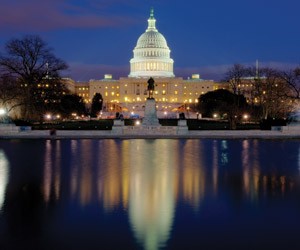Government meeting planners—especially those at the state level—continue to grapple with tight budgets, recognition of meetings value and even their own value to government agencies and departments.
Yet the industry sector is making impressive strides towards improved professional recognition as it prepares for an improved business environment.
This concern, along with the value of face meetings and the creative uses of social networking, will be high on the agenda at the annual meeting of the Society of Government Meeting Professionals (SGMP), which is taking place in Norfolk, Va., June 8-11.
Raising the Bar
Even as government meetings funding ebbs and flows, SGMP and its regional chapters are working to raise the bar on professional regard for government employees who regularly do meeting planning, according to Executive Director and CEO Charles Sadler.
As a prime example, he says SGMP had fruitful discussions with the General Services Administration (GSA) earlier this year about getting agencies to recognize government planners as professionals. One result has been GSA’s creation of a department for travel and meetings to oversee meetings spend and implementation in multiple federal agencies.
GSA is also working on setting standards for the meeting planner function in about 82 agencies, including training for those who do the planning—often people in administrative roles where planning is just one of many duties. A new link off the GSA website (www.gsa.gov) provides SGMP training information to those who engage in government meeting planning.
"This is acknowledgement of professionalism," Sadler says. "We are working with GSA to certify people for planning, and certification may be a requirement in the near future for people who perform that function."
At the chapter level, SGMP is implementing a Government Meeting Specialist (GMS) education program for planners and suppliers who want to elevate their knowledge about meeting planning. It covers basic to higher competencies.
"Our Michigan chapter under Debra Kopkau started this GMS program," Sadler says. "They have had one of the weakest state economies in the country recently, but when they established this, they increased their membership to 45 percent last year and sponsorships increased dramatically, too. So now we are taking this program across the U.S. so people have another way to show their bosses value for what they do."
Barbara Shepherd, president of SGMP’s Buckeye Chapter in Ohio and an independent planner, says her group began losing members about a year ago because government offices would not fund attendee expenses for monthly meetings. Her chapter adopted the Michigan model to great benefit.
"State government people started brown bagging and expected everyone else to do so too," she says. "Our attendees had to either pay for a $10 hotel lunch themselves or wait to eat until after the meeting—and hotels wouldn’t allow this to go on. So we lost people.
"Now with the program Michigan started, we are offering Continuing Education Units for attending our monthly lunch meetings," she continues. "For people who are in difficult job situations, this has been a big help because they have something of value to show their bosses."
Tracking Value
Staying on top of technology trends for meetings continues to challenge government planners just as it does those working in the private sector. This year’s annual SGMP conference will include a lot about technology for meetings, along with showing meetings value, according to Sadler.
"Technologies and the value of face meetings will be featured at our 2011 conference," he says. "We have a new Tech Fair that will be separate from the expo. It’s where planners will be able to learn more about how tools like social media can help them get information to people in and outside meetings."
Rob Coffman, deputy director of the Office of Conference, Event and Meeting Services for the U.S. Department of the Treasury in Washington, D.C., believes that knowledge about technology is an important piece in the government planner’s toolbox.
"Government planners have significant challenges when their budgets are being cut, and technology is sometimes the answer to moving forward," he says. "Sometimes technologies can facilitate webinars and teleconferencing sessions for the good, but you must know that sometimes these tools may not be cost effective.
"The latest and greatest may not be your answer," he continues. "You may need to wait until the second or third generation. So staying on top of the developments is a big challenge."
Along with being tech savvy, planners have to know how to prove their worth, Coffman adds.
"People—especially stateside—are concerned about funding of meetings and their own jobs," he says. "So in the face of funding cuts, furloughs and budget constraints, they must know how to show ROI for meetings and their own jobs and that they can negotiate agency savings better than a third party entity or an agency administrator can."
So as government planners continue to struggle with meetings budgets and funding, they are working harder than ever to ensure viable career futures for themselves as meeting professionals.






